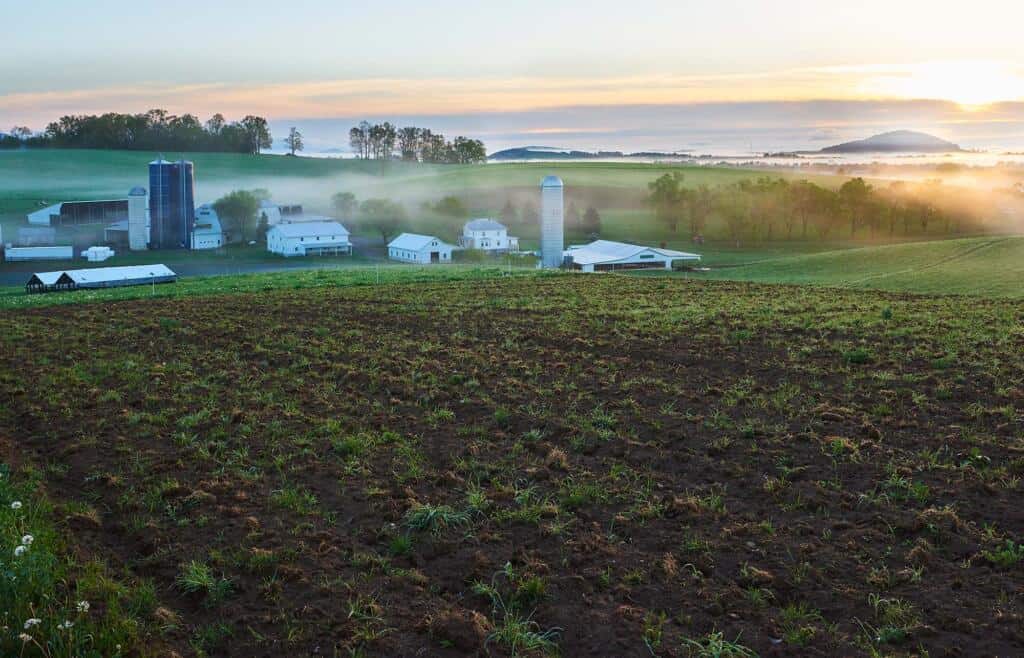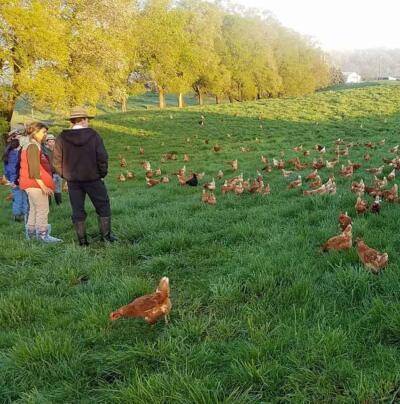Hidden Hollow Farm
Arlen Beery has been farming the same piece of land at Hidden Hollow Farm in Dayton, Virginia, for thirty years. He was one of the farmers that OFRF spoke with about Integrated Crop-Livestock Systems, the practice of raising livestock and crops together in ways that benefit the whole farm ecosystem.

OFRF is honored to share a recording of a conversation with Arlen Beery about Integrated Crop-Livestock Systems at his farm. You can listen now by pressing the “play” button below.
Or click this link to download Arlen’s story to listen later.
- Farm name: Hidden Hollow Farm
- Farmer name: Arlen Beery
- Location: Dayton, Virginia, (traditional homelands of the Shawnee Tribes, Monacan Indian Nation, and Manahoac).
- Products: Dairy, eggs, vegetables, hay, corn, and some beef.
- ICLS practices: Grazing & terminating cover crop, breaking up pasture for crops, breaking pest cycles, clipping hay pastures, on-farm compost.
- Years certified organic: Began transitioning in 2003, certified organic since 2006.
- Acreage: Home farm is 117 acres. Rents another 200 nearby.
- Type of livestock: Large herd of dairy cows, 1000 laying hens.
- Markets: Sells organic grass-fed milk through Organic Valley, a wholesale milk cooperative. Sells eggs and produce through Shenandoah Family Farms, a local producer cooperative.
- Years in operation: Since 1993.
- Farm crew size: Self + extended family.
Harmony in Farming: The Integrated Approach at Hidden Hollow Farm
Arlen Beery has been farming the same piece of land at Hidden Hollow Farm in Dayton, Virginia, for thirty years. He was one of several farmers that OFRF spoke to in a series of interviews about Integrated Crop-Livestock Systems, the practice of raising livestock and crops on the same farm, overlapping on the same ground in ways that can benefit the animals and the plants, as well as the whole farm ecosystem. “In all my years the crops and livestock have both been here,” he said, when asked which came first. “The livestock needed forage and winter feed,” he said. “For us both came together.” His home farm is 117 acres, and he also rents another 200 nearby. Hidden Hollow Farm primarily raises dairy cattle, and sells organic grass-fed milk through Organic Valley, a wholesale milk cooperative. They also raise about 1000 laying hens, produce vegetables, hay, and corn, and occasionally sell some beef.

Although the crops and livestock have both been there from the beginning, they haven’t always been as integrated as they are now. “Years ago when we started we were not grazing,” Arlen said. “We would harvest all the crops we were growing and bale or chop the crop and store it for the cattle to eat in more of a confinement type setting, where cows went to the feed bunk [a type of feeding trough] to get their feed.” In 2003 Arlen began the transition to organic production, becoming certified in 2006. “We moved into grazing at that time,” he explained, “because it’s a national organic program ruling, it’s a requirement.”
There were several things that inspired them to make the shift to organic production. One of the key reasons was to lessen the effect of market swings in the price of fertilizer. They have also noticed a benefit in that it buffers them against the ups and downs in the grain market.
Because the organic model does not depend on synthetic fertilizers and chemicals Arlen’s annual production costs are more predictable. He feeds less grain now that he’s rotationally grazing his cows on pasture, so swings in the grain market also don’t affect his budget as much. Another motivation for going organic was the health and wellbeing of the farm, the soil biology, and the family, including young children who live on the farm. “We were wanting to get to a more natural way of farming,” Arlen said.
Since becoming certified organic and beginning to put their animals on pasture, Arlen has developed a multi-year rotation for his farm to keep his pastures and animals healthy. For seven years, the land is in pasture, and the eighth year in an annual crop (sudan or millet). Starting in the summer before the annual crops will be grown in an area, Arlen puts chickens on that pasture intensely. They then “out winter” the cattle, keeping them on that same piece of pasture through the winter. “In spring there will be a lot of manure left there from cattle and chickens,” Arlen explained. “The sod is thin from livestock being on it. Then we do some tillage, and plant sudan/millet as an annual summer crop.” After about 35 days they are able to start grazing the cattle in that area again, and can return to graze the sudan/millet every month over the summer. In September, after about three grazings, they pull the sudan/millet out and plant the area back into perennial pasture, and keep the animals off it for the first winter so it can get established. When they replant a pasture they include triticale as a “nurse crop.” Triticale grows quickly, so it’s the first thing the animals can graze when they’re put back on the pasture in the spring. They are able to start grazing there in mid March, which is earlier than other pastures that don’t have the triticale present.
Arlen has his farm divided into paddocks about 5 acres in size. They are typically moving about 90 cattle, and rotate them roughly every two days. “The way I farm today, the most important thing is having a perimeter fence around the whole farm that is secure,” Arlen said. “It’s a lot cheaper to let the cows in than to run hay equipment over that ground. That’s something I would recommend to anyone pursuing these ways of farming, to have a strong secure perimeter fence so you can flash graze when needed.” At Hidden Hollow the secure perimeter fence allows them to let cows into an area whenever they need to, so they can have cows clip a pasture, or terminate a cover crop.
While Arlen says that the yields on his crops have not changed much since integrating, there are some other benefits that he has observed. “The health of cattle and chickens is a lot improved,” he said. “Especially for the dairy cows, they are not pushed as hard… so they’re not trying to produce more milk than they were naturally designed to.” Arlen has observed that his cows now have a longer lifespan and better overall health because they’re not on a high energy diet of grains that ruminant animals haven’t evolved to eat. Chickens follow cattle around in the rotation on Arlen’s pastures and are effective in helping to control the parasite load and fly larvae that follow the cattle. Chickens naturally scratch around and help to distribute the cow manure across the fields, which provides health benefits for the chickens as well. “Getting the clover and alfalfa in the fields, as well as crickets and worms, it’s beneficial to them,” Arlen explained, pointing out that it also makes a healthier egg for the consumer.
 Hidden Hollow Farm has also seen improvements in soil health since integrating the livestock onto the cropping ground. “Soil organic matter has increased faster than any other model of farming that I know of,” Arlen said. “The soil health really hums.” As the cows leave patties on the fields, dung beetles burrow into the ground and distribute that manure, transporting nutrients down into the soil. Earthworm activity also increases the soil biology, and the pathways left behind by the dung beetles and the earthworms aid in water infiltration and retention.
Hidden Hollow Farm has also seen improvements in soil health since integrating the livestock onto the cropping ground. “Soil organic matter has increased faster than any other model of farming that I know of,” Arlen said. “The soil health really hums.” As the cows leave patties on the fields, dung beetles burrow into the ground and distribute that manure, transporting nutrients down into the soil. Earthworm activity also increases the soil biology, and the pathways left behind by the dung beetles and the earthworms aid in water infiltration and retention.
“The grazing of cattle is an interesting learning curve,” Arlen said. “Cattle need to learn how to graze, and farmers need to learn how to manage grazing animals. Learning your cattle, learning your farm, learning your environment, your dry times, rainfall, winter, how wet weather affects how you can graze, how much damage you do… Takes time to understand that.” From Arlen’s experience, that process takes three years, and sometimes longer. He pointed out that it’s not just the farmers who have to adjust to the process of rotational grazing. Cows also need to learn to graze, if they have not been raised that way. From Arlen’s observations it takes a cow growing up as a calf on a grazing model before they learn to be good grazers and are able to keep good body condition. “There’s no way that you can start out as a new inexperienced grazing farmer and be able to do [it] just right in the beginning. There’s no way to go into a farm and do it by the textbook.”
Fortunately there are farmers like Arlen who are willing to share their experiences of the challenges and the advantages of integrating their crop and livestock production to help educate and inspire other farmers to make the leap. Surveys of organic farmers have shown that farmer-to-farmer learning is one of the most preferred methods to receive information, so the willingness of farmers like Arlen to share their experience is paramount. Although it takes time to learn the nuances of how land, livestock, and crops work together, and to develop the integrated systems, Hidden Hollow Farm is a great example of the long term benefits that crop-livestock integration can have on animal, crop, and soil health.


